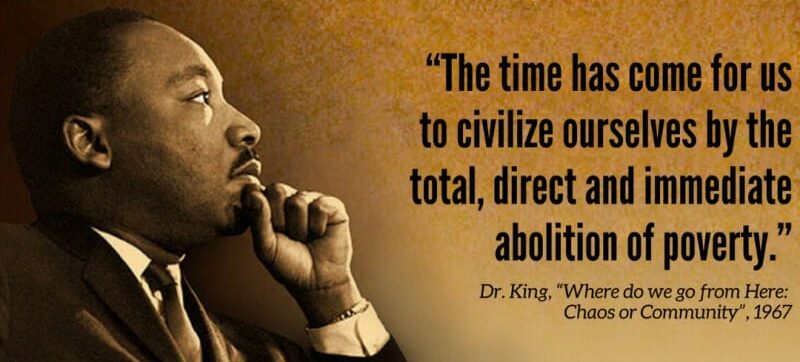On Wednesday, LAPA hosted a panel discussion in remembrance of Dr. Martin Luther King, Jr. His legacy is often simplified to anti-racism work, but his work was unmistakably intersectional and considered poverty an equally devastating societal ill.
In reflecting on King’s legacy, we embrace a need to connect our own work to the eradication of poverty. Whether you’re a drug treatment program or an animal shelter, a dance studio or literacy program: we all have a part to play, no matter your mission.
Economic Justice for those who use your nonprofit is an imperative because when people’s incomes rise, poverty reduces. Social services and rental assistance are important, but they are steppingstones toward the real goal of raising income, raising the minimum wage, having a basic living wage, and reducing and eliminating student debt.
Amidst a global pandemic, the US gained 56 new billionaires, bringing the total to 659. Yet, during this same time, Covid-19 took the lives of black people at twice the rate of white Americans. 401,000 people are dead from the virus, the deaths disproportionate along lines of both class and race. Economic analysts at Moody’s project a wave of evictions between 760,000 and 4 million nationwide.
How do we fundraisers respond? What is required of us to fight poverty at this time?
As we contextualize our own fundraising work through the lens of poverty eradication, I think of the 3.5% rule. Do you know it? We all have a real temptation to think reducing poverty is insurmountable. The research by Erica Chenoweth reminds us it is not.
The Good News: the 3.5% Rule
Erica Chenoweth, a political scientist at Harvard University, looked at hundreds of social change campaigns over the last century and found that nonviolent campaigns are twice as likely to achieve their goals as violent campaigns. And although the exact dynamics will depend on many factors, she has shown it takes around 3.5% of the population actively participating in a campaign to ensure serious political change.
Chenoweth points out that while 3.5% is a small minority, such a level of active participation probably means many more people tacitly agree with the cause.
Methodology & Findings
Chenoweth performed an extensive review of the literature on civil resistance and social movements from 1900 to 2006 – a data set then corroborated with other experts in the field. By the end of this process, they had collected data from 323 violent and nonviolent campaigns. And their results – which were published in Why Civil Resistance Works: The Strategic Logic of Nonviolent Conflict – were striking. Overall, nonviolent campaigns were twice as likely to succeed as violent campaigns: they led to political change 53% of the time compared to 26% for the violent protests. “There weren’t any campaigns that had failed after they had achieved 3.5% participation during a peak event,” says Chenoweth.
At this tender juncture in our country’s trajectory, the fundraiser’s role is not simply about raising funds—it never was. It’s about addressing and solving the social problems that define your nonprofit’s mission.
How can the 3.5% rule be replicated in your fundraising work and community?





